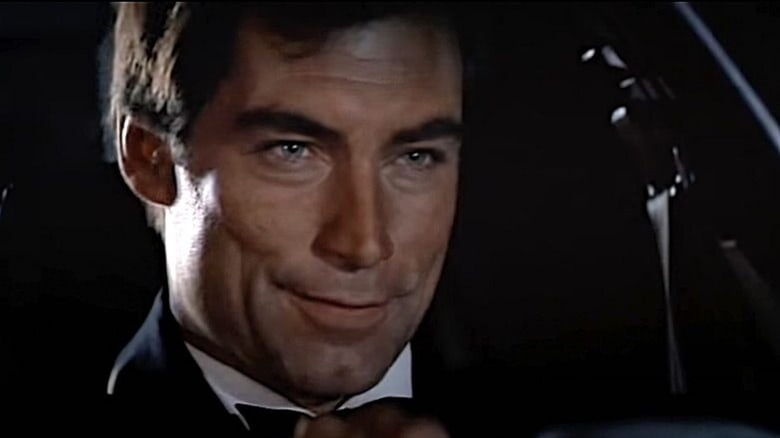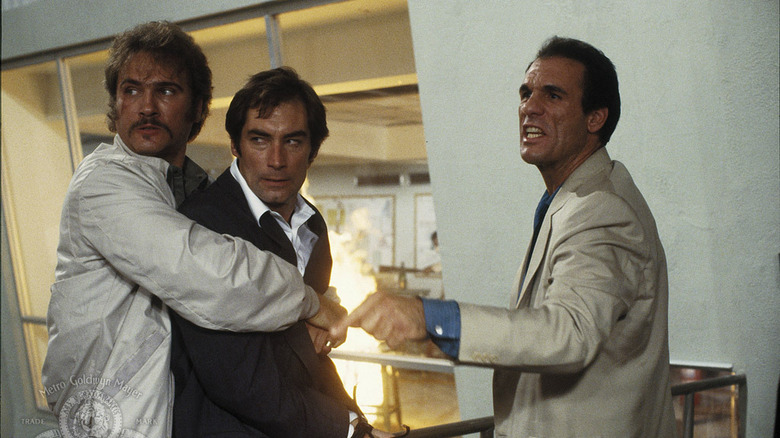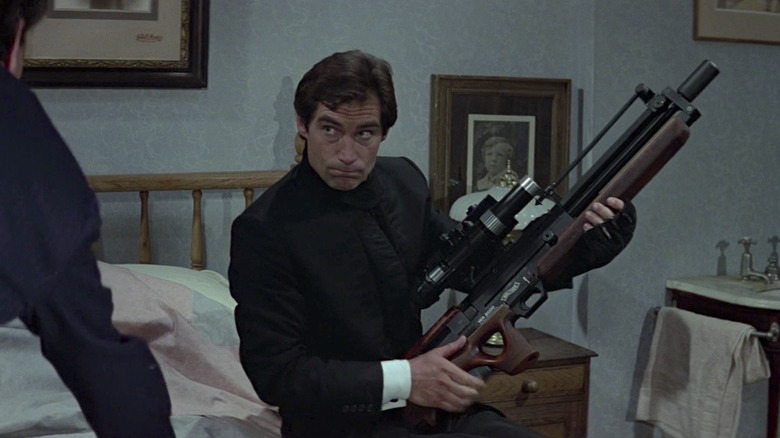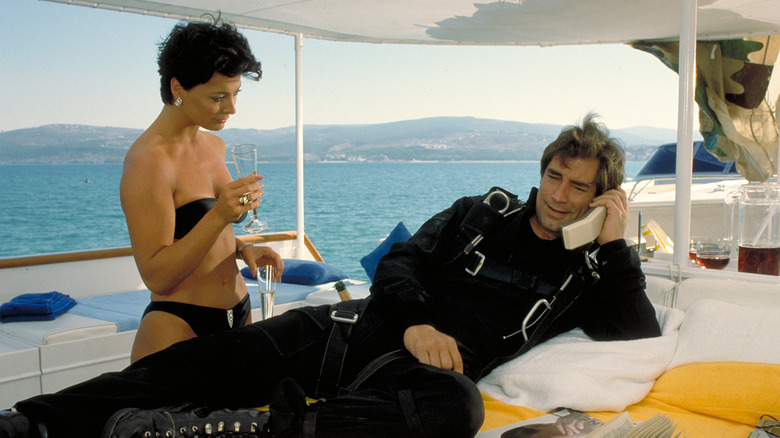Timothy Dalton Has A Theory On Why His James Bond Went Underappreciated
Roger Moore turned 58 while he was shooting his seventh James Bond feature "A View to a Kill." He'd already huffed and puffed his way through action sequences in his previous 007 effort, "Octopussy," but he looked downright spent in this Summer of 1985 offering. It was time for Moore to hand over his Walther pistol, but replacing him would be no small feat. Having occupied the role for 12 years (three more than Sean Connery), Moore had come to exemplify the role for an entire generation, most of whom were born after Ian Fleming had published his final Bond novel. For this cohort, his suave, yet silly characterization was what Bond was supposed to be.
The transition to a new Bond was further complicated by the overall crappiness of "A View to a Kill." From the snowboarding set piece (scored to the chintziest version of "California Girls" ever recorded) to the limp airship finale over the Golden Gate Bridge, "A View to a Kill" was deemed by many to be the nadir of the franchise. Also, Bond's debonair style felt somewhat passé in the macho age of Sylvester Stallone, Arnold Schwarzenegger, and Chuck Norris; indeed, "Rambo: First Blood Part II" handily outgrossed "A View to a Kill" over the Memorial Day weekend of 1985.
Finally, there was the Pierce Brosnan fiasco. The rising star of NBC's "Remington Steele" appeared tailor-made for the role. The producers agreed, but their offer to Brosnan was undercut by the network, which exercised an option in Brosnan's contract for a fifth season of the drama (which had just been canceled). At this point, the fourth James Bond was going to be viewed as Option B to Brosnan.
Poor Timothy Dalton never stood a chance.
Taking Bond back to his killer roots
Though Dalton was fairly well known in the U.K. for his theatrical work and his preening turn as Prince Barin in Mike Hodges' "Flash Gordon," he'd failed to make an impression in the U.S. This meant MGM/UA had to redouble its marketing efforts on selling the 007 brand. While the title of Dalton's Bond debut, "The Living Daylights," lacked for sizzle, the movie brought the ruckus. It's a muscular action film, more modern in tone than Moore's last two films, and stuffed with dazzlingly dangerous stunt work. Clearly, director John Glen and the producers were on a mission to prove to moviegoers that when it came to blockbuster spectacle, nobody does it better than Bond.
Dalton was more than up to the task. He's more rugged than Moore, and less aloof than Connery. He was not, however, terribly adept at tossing off the character's obligatory quips — or, rather, his portrayal seemed at odds with such flippancy. His Bond was a straight-up killer with a mild romantic streak. He was vulnerable, but he didn't want anyone else to know his stony demeanor was crackable. Basically, if you'd cast him in "On Her Majesty's Secret Service," you would've had an undisputed masterpiece.
"The Living Daylights" set a three-day opening weekend record for the Bond series when it hit U.S. theaters on July 31, 1987. The Washington Post and The New York Times raved, but Gene Siskel and Roger Ebert turned their hugely influential thumbs downward. By the end of its theatrical run, "The Living Daylights" narrowly outgrossed "A View to a Kill," which was troubling to the franchise's stewards. Either audiences were worn out on Bond, or they'd hired the wrong guy for the part. 25 years and 13 movies after "Dr. No," it was easier to blame Dalton than the movie.
Dalton goes two and out
When Dalton's second Bond flick, "Licence to Kill," stiffed at the U.S. box office, he was out. The damage to the brand was considerable enough for the producers to place it on ice for six years. While Pierce Brosnan returned the franchise to commercial prominence with his four-film run, Bond didn't become culturally relevant again until Daniel Craig portrayed the double agent as a straight-up killer struggling to mask fissures in his stony facade.
Sound familiar? These similarities weren't lost on Dalton. Two decades after "Licence to Kill," the actor gracefully discussed his ill-fated, ahead-of-its-time take on 007 with Entertainment Weekly. He began by contrasting the interpretations of his fellow Bonds:
"Roger Moore was marvelous at what he did, and his films were successful, so you can't say a word against him. But Connery was shocking. And his movies were shocking. You had never seen women in bikinis in films in those days, and heroes did not shoot unarmed people. But Connery did, and he was tough. The fight in the train with Robert Shaw [in 'From Russia With Love'] was one of the great Bond sequences. Incidentally, those two sequences, the fight in the train and the shooting of the unarmed man, were reprised in the opening of 'Casino Royale.'"
He then addressed why his Bond failed to connect with mainstream audiences:
"We wanted to take it back to that earlier toughness. But, of course, it's got to be funny. It should be funny. Out of great danger often comes great humor. But when we made 'The Living Daylights' and 'Licence to Kill,' everybody by then was so used to something else. I think people like to stay with what they're comfortable."
The right Bond at the wrong time
Craig and "Casino Royale" had two significant developments working in their favor: the down-and-dirty action of the "Bourne" franchise and Hollywood's sudden interest in parkour stoked by Pierre Morel's "District B13." Most American moviegoers hadn't seen the latter prior to "Casino Royale," so the film's opening foot chase felt revolutionary in a way the masterfully executed training-exercise-gone-murderously-wrong kickoff to "The Living Daylights" didn't.
But Dalton makes a good point about the humor. After Bond kills his way out of trouble in that "The Living Daylights" prologue, he parachutes onto the yacht of a bored socialite yearning for the perfect man to drop into her life. He corrals her newfangled cellular phone to call in to his superiors, asking them to pick him up in an hour. When the quite attractive woman approaches him with two glasses of champagne, he says, "Better make that two." While Connery and Moore would've smashed that line. Dalton's delivery is a tad sheepish. It's in-character for previous Bonds, but not exactly right for his Bond.
The Bond braintrust had grown so accustomed to Moore's autopilot portrayal that they couldn't adjust for Dalton's darkly shaded read on the character. They were trying to feed a triumphal, late-'80s, end-of-the-Cold-War high, while their star was edging closer to Fleming's 007 than any of his predecessors. Time has been kind to both "The Living Daylights" and "Licence to Kill," but moviegoers simply weren't ready for a flawed Bond at the close of the Reagan/Thatcher era. Dalton, and the series, deserved so much better.



